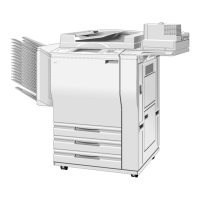RICOH GROUP COMPANIES
CONTROL NO. 351
8)',2-'%0#7)6:-')#&900)8-2
&900)8-2#291&)6U %EKFf%EMM#h#NFN#6)-779)#
+
NIfEEfMM
%440-'%&0)#13()0U
####+)78)82)6#h#FJNJfFJNJ)
####6-'3,#h#%*-'-3#IENJfIFNJ
####7%:-2#h#7('FNJf7('FNJ)
SUBJECT: LIGHT COPIES
SYMPTOM:
Light copy quality in high image density areas or poor solid fill at around 1K to a few thousand scans after
developer replacement. One or more of the following may be observed.
1. Development gamma (SP Data Output page 3) is high (around 4 or more).
2. Vcnt compensation value (difference between Vcnt0 and Vcnt on SP Data Output page1) is large.
3. Vt is not so different from Vref and does not look abnormal.
4. Vk is high (around 15V or more).
CAUSE:
Depending on the characteristics of the ID sensor, the OPC drum, and other related components, the
Process Control Self Check may detect that development gamma (as detected by the ID sensor) is too high.
This in turn may cause an increase of the Vcnt compensation values. An increase in Vcnt compensation
values can result in light copies.
SOLUTION:
So that the Vcnt correction system can not over compensate, turn off the Vcnt correction system and
manually input a fixed Vcnt compensation value.
PROCEDURE:
1. If you have previously adjusted Vref (SP Data Output page 1) return it to the Vref0 values for BK,Y,M,C.
Record these Vref0 values of BK, Y, M, and C. Continued…
Note:
This copy is intended as a master original
for reproduction of additional bulletins.
„
COPY QUALITY
+

